
Scoparia pyralella, the meadow grey, is a species of moth of the family Crambidae. It was first described by Michael Denis and Ignaz Schiffermüller in 1775.

Eudonia octophora is a species of moth of the family Crambidae. It was named by Edward Meyrick in 1884. It is endemic to New Zealand.

Ichneutica omoplaca is a moth of the family Noctuidae. It is endemic to New Zealand. It is widespread from the Bay of Plenty in the North Island down to Southland in the South Island. Specimens have also been collected from the Auckland Islands. It lives in a variety of habitats including beech forest clearings and tussock grasslands. This species has been recorded that some of the larval hosts of this species include Poa cita, Dactylis glomerata and it has been reared on Plantago lanceolata. The larva is undescribed but pupae have been found in a pine plantation in soil under weeds. Adults of this species are on the wing from October to March. The adult moths are variable in appearance but the diagnostic feature is the pale ochreous to white colouring between the basal streak and the costa which contrasts with the ground colour of the forewing.
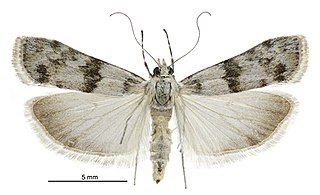
Eudonia asaleuta is a moth of the family Crambidae. It was described by Edward Meyrick in 1907. It is endemic to New Zealand and has been collected in the South Island in the West Coast, Fiordland,Canterbury, Otago and Southland regions. This species inhabits bare shingle areas as well as tussock habitat with few trees or scrub at altitudes of under 1000 m. Adults are on the wing from November to February.

Scoparia ejuncida is a moth of the family Crambidae. It was described by Henry Guard Knaggs in 1867. It is endemic to New Zealand.

Ichneutica steropastis, or the flax notcher moth, is a species of moth in the family Noctuidae. It is endemic to New Zealand and can be found throughout the country from the Three Kings Islands to Stewart Island as well as in the Chatham Islands. The larvae of this species feed on a variety of native and introduced plants however the New Zealand flax is one of the more well known host plants for the larvae of this moth. The larvae are nocturnal, hiding away in the base of the plants and coming out to feed at night. They create a distinctive notch in the leaf when they feed. The adults of this species are on the wing from October to March. Although adult specimens of I. steropastis are relatively easy to recognise they might possibly be confused with I. inscripta, I. theobroma or with darker forms of I. arotis. However I. steropastis can be distinguished as it has a long dark basal forewing streak that these three species lack.

Eudonia asterisca is a moth in the family Crambidae. It was named by Edward Meyrick in 1884 and is endemic to New Zealand. It has been recorded in both the North and South Islands. This species is recorded as being present at sea level up to altitudes of 1350 m. This species has been recorded as inhabiting native podocarp/hardwood forests. The adults of this species are on the wing from December until March although they have also been recorded in October and November. They are attracted to light and have also been trapped via sugar traps.
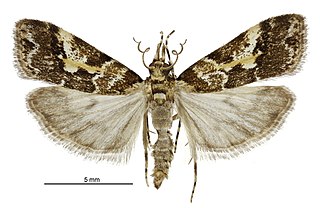
Eudonia characta is a species of moth in the family Crambidae. It was named by Edward Meyrick in 1884 and later more fully described the species. It is endemic to New Zealand.

Eudonia cymatias is a moth in the family Crambidae. It was named by Meyrick in 1884. This species is endemic to New Zealand.
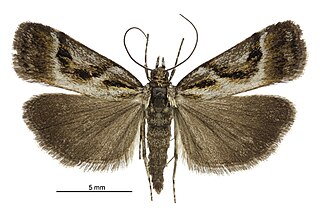
Eudonia hemicycla is a moth in the family Crambidae. It was described by Edward Meyrick in 1884. This species is endemic to New Zealand.

Eudonia legnota is a moth in the family Crambidae. This species was named by Edward Meyrick in 1884. It is endemic to New Zealand.

Eudonia leptalea is a moth in the family Crambidae. This species is endemic to New Zealand, including the Chatham Islands.

Eudonia manganeutis is a moth in the family Crambidae. It was named by Edward Meyrick in 1884. It is endemic to New Zealand.

Eudonia microphthalma is a moth in the family Crambidae. It was described by Edward Meyrick in 1884. It is endemic to New Zealand.

Eudonia psammitis is a moth in the family Crambidae. It was named by Edward Meyrick in 1884. Meyrick gives a description of the species in 1885. It is endemic to New Zealand, including the Campbell Islands.

Eudonia zophochlaena is a moth in the family Crambidae. It was described by Edward Meyrick in 1923. It is endemic to New Zealand. It has been hypothesised that this species is a North Island endemic. The adults of this species are on the wing from December until February. The larvae of this species are leaf miners of the leather-leaf fern Pyrrosia eleagnifolia.

Eudonia meliturga is a moth in the family Crambidae. It was described by Edward Meyrick in 1905. This species is endemic to New Zealand.
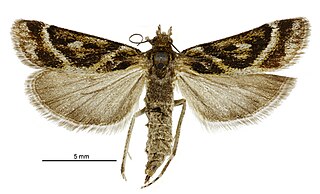
Eudonia xysmatias is a moth in the family Crambidae. It was first described by Edward Meyrick in 1907. This species is endemic to New Zealand and has been observed and collected in Otago. This species inhabits wetlands. Adults are day flying and are on the wing in December and January.
Eudonia exilis is a moth in the family Crambidae. It was described by Henry Guard Knaggs in 1867. It is found in New Zealand.
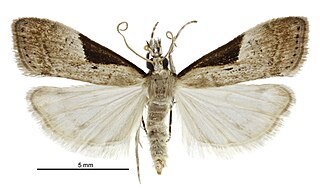
Eudonia pongalis is a moth in the family Crambidae. It was described by Cajetan Felder, Rudolf Felder and Alois Friedrich Rogenhofer in 1875. It is endemic to New Zealand.




















